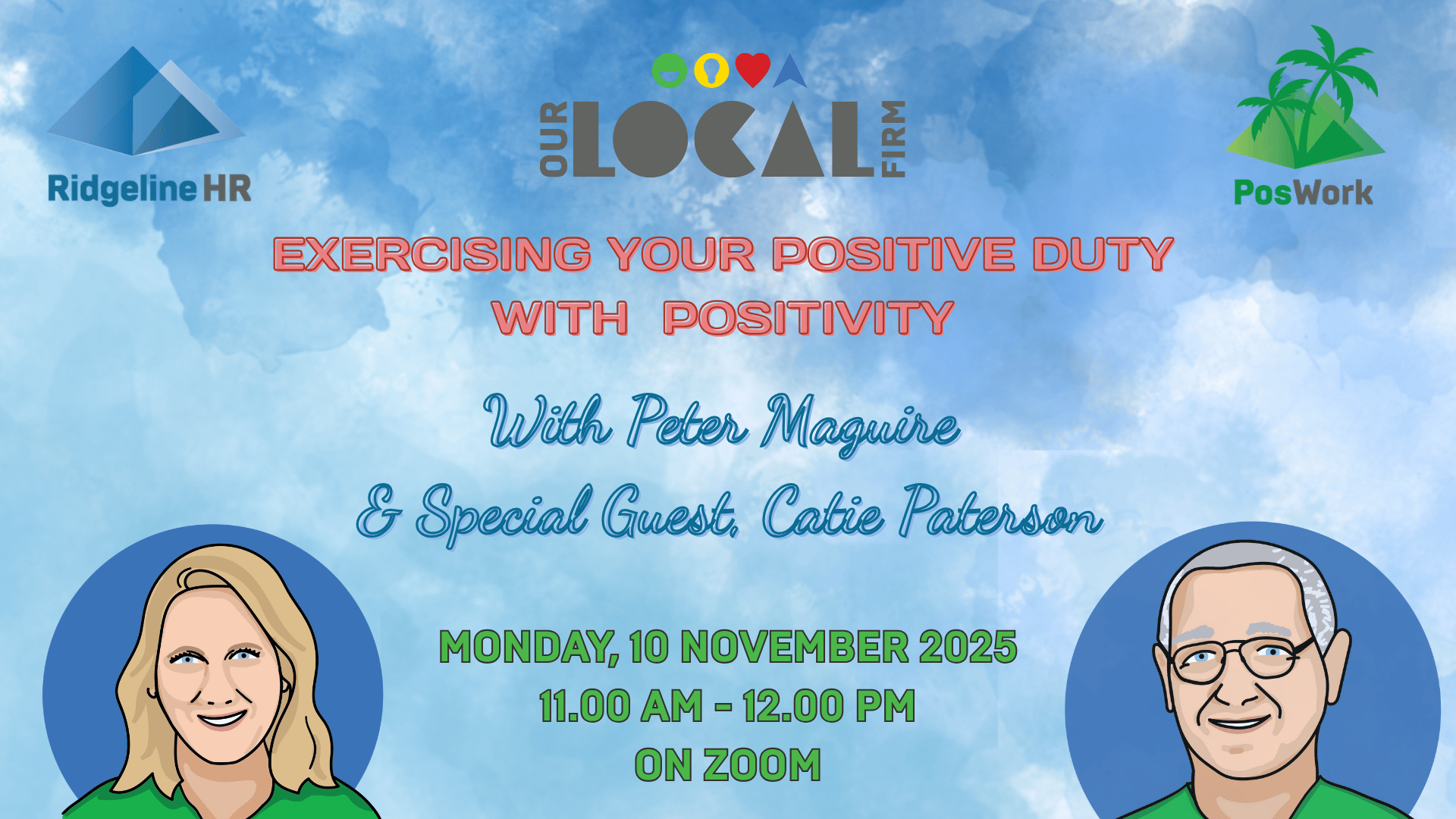|
Arrival of positive duties
One of those changes is the relatively new positive duty to prevent sexual harassment, sex discrimination and gender-based behaviours which became enforceable under the Commonwealth “Sex Discrimination Act 1984” in December 2023.
The Australian Human Rights Commission has compliance and enforcement powers whereby it can enter workplaces for inspections, interview staff and initiate prosecutions for breach of that positive duty.
We have also seen new positive duties to eliminate or control risks associated with psychosocial hazards which include sexual harassment and gender-based behaviours become operative in most States and Territories of Australia under Workplace Health and Safety laws. It has recently been announced that this will happen in Victoria late this year and there is already a panel of Psychosocial Hazard Worksafe Inspectors operating in Victoria.
What difference do positive duties make?
The traditional approach to dealing with such issues as sexual harassment has been to have a policy to express commitments, procedures for dealing with issues and training to educate people on expectations and then to act on any complaints or breaches reported.
That has proven to be ineffective in preventing sexual harassment.
The positive duty means that organisations now have to conduct risk assessments to determine whether there are any hazards that give rise to risks of sexual harassment and related behaviours and, if there are any such hazards, to implement appropriate control plans, much as has been required for physical WHS risks for many years.
Risk factors in construction
Here are some of the risk factors that are featured in publications by the AHRC:
· most of your workers are men
· most of the supervisors or managers in your workplace are men
· your business involves interacting with third parties (such as clients, customers and/or others)
· you employ casual staff and/or workers on short-term contracts
· your workplace is very hierarchical
· your workplace lacks diversity
· your workplace is isolated or remote
· your workplace is divided by gender (for example, women in the office, men ‘on the tools’)
· alcohol is consumed, especially at work social events
· you and/or your staff do not understand sex discrimination, sexual harassment, and other unlawful behaviours
· disrespectful behaviour is generally accepted or common in your workplace
· you don’t have a policy or code of conduct which sets expected standards of behaviour
· you have not responded appropriately or held people accountable for unlawful behaviours in the past (or have not applied a policy or code of conduct consistently).
How many of those risk factors are present in your workplace? If you are in civil construction, probably most of them.
The Australian Human Rights Commission Framework
The AHRC has developed a set of 7 standards for complying with the positive duty in preventing and responding to sexual harassment and related behaviours and these are:
1. Leadership
2. Culture:
3. Knowledge
4. Risk management
5. Support
6. Reporting and response
7. Monitoring, evaluation and transparency
There is some excellent guidance material available at https://humanrights.gov.au
The Leadership Standard
Of those 7 standards, the one that has been called out as the most important is “Leadership” because that is where it all starts.
The standard describes the leadership responsibilities as follows:
1. Senior leaders understand their obligations under the Sex Discrimination Act and have up-to-date knowledge about relevant unlawful conduct.
2. Senior leaders are responsible for ensuring that appropriate measures for preventing and responding to relevant unlawful conduct are developed, recorded in writing, communicated to workers and implemented. Senior leaders regularly review the effectiveness of these measures and update workers.
3. Senior leaders are visible in their commitment to safe, respectful and inclusive workplaces that value diversity and gender equality. They set clear expectations and role model respectful behaviour.
‘Senior leader’ refers to any person with responsibility for the management and governance of the organisation or business.
In a small organisation or business, this will usually be the owner and any manager.
In larger organisations and businesses, this will usually include the board (or equivalent), chief executive officer (CEO), executive leadership team (ELT), partners or executive manager.
Senior leaders hold ultimate responsibility and accountability for the governance and legal compliance of their organisation or business.
They are responsible for their own actions, the actions of those who they lead and influence, allocation of resources, oversight of compliance and shaping the broader workplace culture.
They set the ‘tone from the top’ – meaning that what they say and do gives a strong message to workers about what is acceptable, important and valued.
What the Australian Institute of Company Directors has to say
The Australian Human Rights Commissioner called on the AICD to help in education of directors about sexual harassment, its drivers and things that they need to be doing to meet their duties as directors in this context.
The AICD has developed: “A director’s guide to preventing and responding to sexual harassment at work”. In essence, it follows the 7 standards published by the AHRC. It also notes some really important questions that Boards should be considering including:
· Do all directors have an adequate understanding of workplace sexual harassment and its drivers?
· Are you confident directors’ personal communication styles and behaviour model the desired culture?
· Do you discuss this at board level?
· Are you comfortable that the board understands the dynamics and prevalence of sexual harassment in the organisation and how it relates to the organisational culture?
· Does the board, or relevant board committee, consider workplace sexual harassment risks in overall risk management and governance?
So, you can see that the expectations of senior leaders go a long way beyond just putting policies in place – they need to be leading from the front and that starts at board level.
The Queensland development
From 1 March 2025, if a risk has been identified, employers must also implement a comprehensive, written prevention plan that identifies risks, control measures for managing these risks if elimination is not practicable and the process for consulting with employees during its development.
Employers will need to consider specific worker, workplace and work environment characteristics, such as lack of diversity or isolated work, which may heighten the risk of sexual harassment and sex or gendered-based harassment occurring in their workplace.
In essence, this means that any business needs to conduct a risk assessment in line with regulations and the Code of Practice and develop a control plan on how each identified risk will be mitigated.
This applies to all Persons Conducting a Business or Undertaking which has people working in Queensland.
New jurisdictions at the Fair Work Commission
The FWC has been able to issue stop sexual harassment orders for some years, but it isn’t a jurisdiction that saw a lot of activity for the simple reason that, unless the alleged perpetrator was still working in the organisation, there was essentially nothing to stop, and often cases could fail to result in any action on jurisdictional grounds.
If the alleged sexual harassment happened after 6 March 2023, the FWC can also conciliate on sexual harassment disputes and either issue a certificate to allow a court application to proceed or arbitrate itself and has powers to award compensation among other things.
Conclusion
The challenge starts with senior leadership in our organisations which means, in an industry such as ours, it predominantly starts with the men in those senior leadership roles, whether on boards or executive teams in larger organisations or business owners and managers in smaller ones.
And the process starts with understanding the truths about sexual harassment and gender-based behaviours, what drives them and what impacts they have on people plus what your obligations as a senior leader involve.
Beyond that, it is playing your part individually and collectively to drive the cultural change that is necessary to make the industry a psychologically and emotionally safe place for people and women in particular.
Who is up for that challenge?
This article was originally produced for CCF Victoria’s Bulletin publication.
Please call us on 0438 533 311 or email enquiries@ridgelinehr.com.au if you want to explore how we might be of assistance.
|










